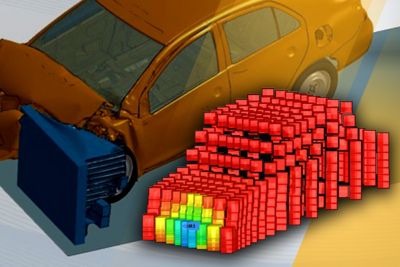Accelerating Ansys LS-DYNA Simulations with Reduced Order Modeling and Hybrid Analytics
Discover how Ansys tools like Twin Builder ROM streamline LS-DYNA crash simulations, optimize workflows, and accelerate robust system development.
Ansys stellt Studierenden auf dem Weg zum Erfolg die Simulationssoftware kostenlos zur Verfügung.
Ansys stellt Studierenden auf dem Weg zum Erfolg die Simulationssoftware kostenlos zur Verfügung.
Ansys stellt Studierenden auf dem Weg zum Erfolg die Simulationssoftware kostenlos zur Verfügung.
Für die Vereinigten Staaten und Kanada
+1 844,462 6797
Discover how Ansys tools like Twin Builder ROM streamline LS-DYNA crash simulations, optimize workflows, and accelerate robust system development.
Venue:
Virtual
Crash simulations in LS-Dyna are essential for analyzing complex scenarios involving various physical models Fine mesh models are often used to achieve accurate results, significantly increasing computational demands. One of the main challenges is the lengthy simulation time required for each design point, particularly when exploring large design spaces with multiple parameters. This makes optimizing accuracy and efficiency a critical focus in crash simulation workflows.
Our current solution leverages the new capabilities of the Twin Builder Static ROM, which includes transient output and is known as the Parametric Field History ROM. The results are exported from LS-Dyna to LS-Opt Pro, with an automated workflow to generate the training data in the format required by the Twin Builder ROM Builder.
In crash simulations, data is often collected across numerous points within the design space, requiring the creation of multiple reduced order models (ROMs). Using tools like PyAnsys, PyAEDT, and PyTwin, you can automatically generate and evaluate these ROMs, ensuring efficiency and accuracy. ROMs demonstrate strong predictive capabilities while significantly reducing simulation time. Additionally, simulation time can be further optimized by building ROMs from low-fidelity models and enhancing predictions with selected high-fidelity simulations through techniques like fusion modeling.
This provided solution will enable customers to reduce the development and optimization time of a restraint system, secure the robustness of their restraint system during the vehicle development process for many parameters, and finally support test engineers by replacing the expensive test with ROM simulation.
Engineers interested in digital twins, LS-DYNA and AI/ML techniques
Mohammad Aghsaee
